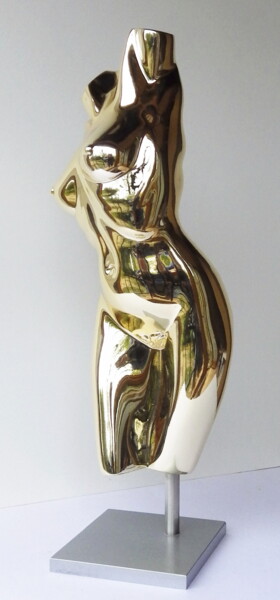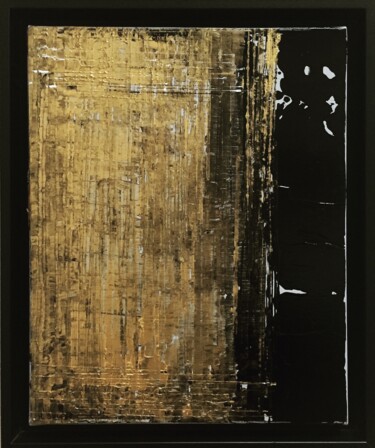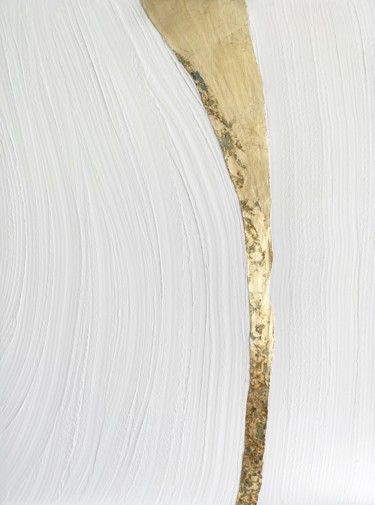The "Fondo oro" Painting Technique
Gold has been the protagonist of many masterpieces in the history of art, created through the painting technique of the "Fondo oro", which, spread initially in the early Christian mosaics, was later used in the production of paintings on wood, miniatures and mosaics of the Byzantine period. This technique, perfectly described in the treatise of about 1400 by Cennino Cennini, entitled "Libro dell'arte", is based on the production of small and thin gold leaves, which, the specialized artisans of the Middle Ages, realized by hammering the coins, in order to obtain very thin sheets of metal. Subsequently, the surface of the work, which had been ready to receive the gold leaf, was prepared by spreading a layer of "bolo", a reddish clay dissolved in water and egg white. Then, to fix the gold to the support of the painting, water-based mordants were used, such as egg white, honey, gum and vegetable juices. It should be noted that, during the realization of this technique, the gold leaf was applied in rectangles, which, subsequently transferred to a brush, were applied to the surface through the pressure of the bristles. Finally, the gold was crushed and polished on the support with the burnisher, a special brush made of agate stone flattened at the end.
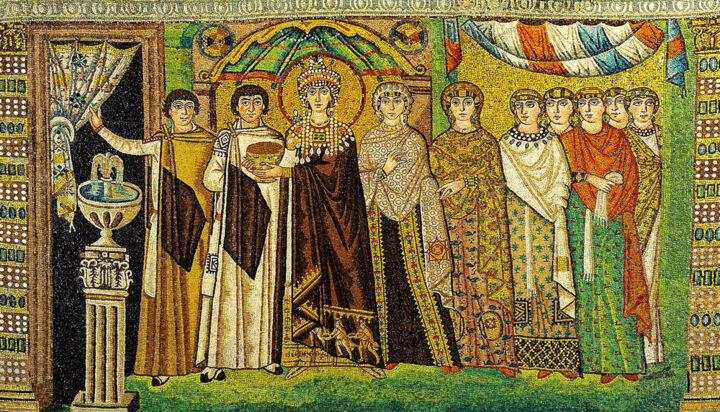 Procession of Theodora, sixth century. Mosaic, Ravenna: basilica of San Vitale.
Procession of Theodora, sixth century. Mosaic, Ravenna: basilica of San Vitale.
Ravenna and Byzantine Art
A masterpiece distinguished by its golden background is the magnificent Byzantine mosaic entitled Procession of Theodora, which, preserved in the Basilica of San Vitale in Ravenna, Italy, dates from around 520-547. This work depicts the Empress Theodora, who, placed in the center of the mosaic, is flanked on the right by two male figures, and on the left by seven overlapping female figures. Within this group of people, only Theodora and the figures closest to her are oriented frontally to the plane of the mosaic, while the other protagonists are slightly removed from it. With regard to clothing, the women of the procession wear very rich clothes and the men, most likely two dignitaries, wear a tunicwith a tablion chlamys on top. The empress, on the other hand, who is portrayed in a white tunic edged in gold, covered by a purple chlamys, wears showy jewels and a very elaborate headdress. With regard to the way in which the characters are depicted, their bodies are mainly asymmetrical and they are immortalized in rigidly frontal and stylized poses. In addition, the absence of chiaroscuro and the strong contour lines give life to two-dimensional figures, which are devoid of plasticism. Moreover, with regard to the manner in which the characters are depicted, it should be noted that the figure of Theodora is larger than the others, following the laws of hierarchical perspective, which is linked to a type of symbolic representation, where the lineage of the characters is highlighted. Finally, as for the background of the work, the latter, golden and two-dimensional, surrounds the protagonists of the scene, who have their feet resting on a green "carpet". Moreover, in the environment there are also a small fountain, a niche covered by a small shell-shaped apse and, at the top on the right, a striped cloth. Returning to the gold color of the background, this alludes to spirituality, while the purple of Theodora's chlamys represents the power conferred on emperors. In fact, this mosaic, which most likely does not depict a real event, is to be considered a work of political propaganda.
 Duccio di Buoninsegna, Majesty of the Cathedral of Siena, 1308-11. Tempera on panel, 214 x 412 cm Siena: Museo dell'Opera Metropolitana del Duomo.
Duccio di Buoninsegna, Majesty of the Cathedral of Siena, 1308-11. Tempera on panel, 214 x 412 cm Siena: Museo dell'Opera Metropolitana del Duomo.
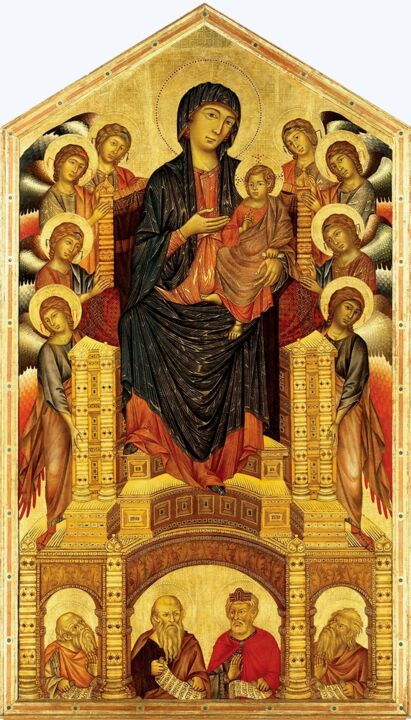 Cimabue, Majesty of the Holy Trinity, 1290-1300. Tempera on panel, 384 x 223 cm. Florence: Uffizi Gallery.
Cimabue, Majesty of the Holy Trinity, 1290-1300. Tempera on panel, 384 x 223 cm. Florence: Uffizi Gallery.
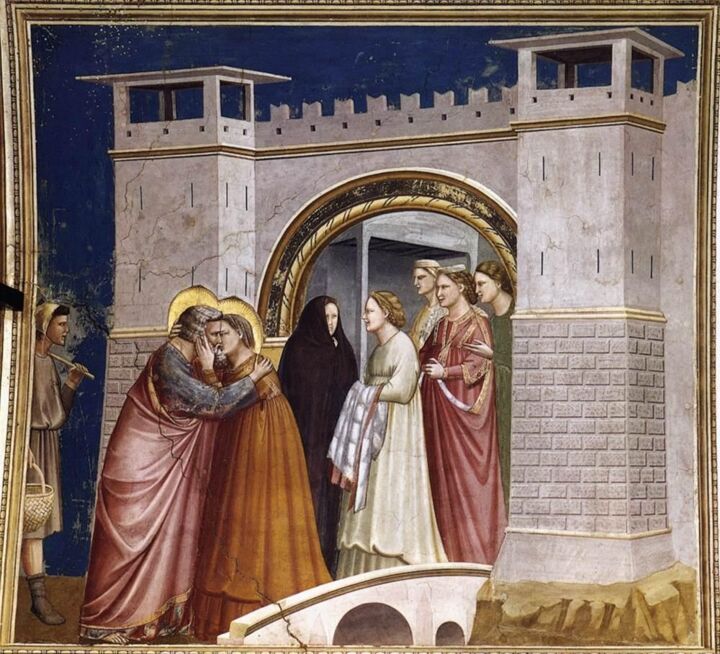 Giotto, Meeting at the Golden Gate, 1303-1305. Fresco, 200 ×185 cm. Padua: Scrovegni Chapel.
Giotto, Meeting at the Golden Gate, 1303-1305. Fresco, 200 ×185 cm. Padua: Scrovegni Chapel.
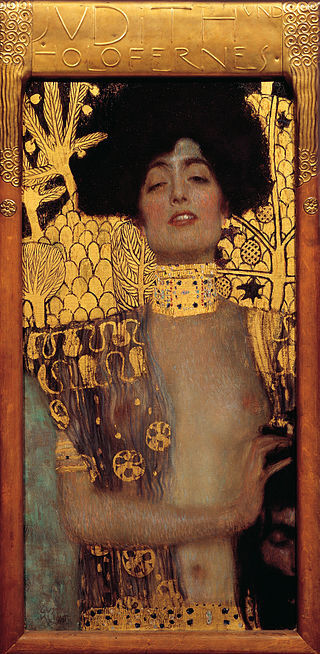 Gustav Klimt, Judith, 1901. Oil on canvas, 84 × 42 cm. Vienna: Österreichische Galerie Belvedere.
Gustav Klimt, Judith, 1901. Oil on canvas, 84 × 42 cm. Vienna: Österreichische Galerie Belvedere.
The gold background from the Middle Ages on...
Italian masterpieces from the Middle Ages to the early Renaissance were distinguished by the use of the technique of the "Fondo oro", which was linked to a precise symbolic value, aimed at alluding to the unreachable and sacred celestial sphere. Example of what said are the works of two Tuscan painters, such as the Majesty of the Cathedral of Siena of Duccio di Buoninsegna and the Majesty of the Holy Trinity of Cimabue. Later, with the contribution of Giotto's artistic investigation, the gold background and Byzantine schematics were partially abandoned and painting returned to depict the world and, above all, the sky. In fact, from the fourteenth century onwards, architectural and landscape backgrounds gradually began to dominate, gradually reducing the percentage of the panel decorated in gold. In the Renaissance, the awareness of the importance of realistic backgrounds was definitively affirmed, so much so that the Gold Background technique began to be less popular. Despite this, the technique never completely disappeared, remaining in use even in the sixteenth century and establishing itself more in the areas of influence of the Orthodox religion, where the cult of icons spread. In modern times, the gold background has been used by many artists, among whom, the most famous is undoubtedly Gustav Klimt.
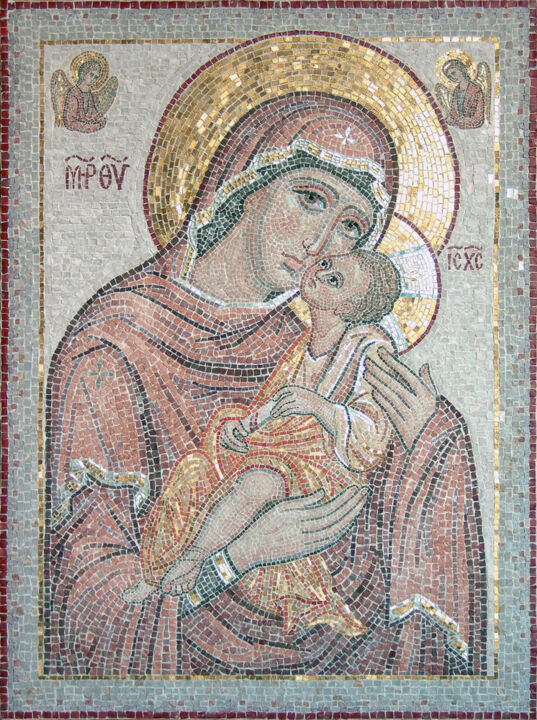 Alena Masterkova, Icon of our lady of tenderness, 2007. Mosaic on wood, 82 x 62 cm.
Alena Masterkova, Icon of our lady of tenderness, 2007. Mosaic on wood, 82 x 62 cm.
Alena Masterkova: Icon of our lady of tenderness
The color gold, used for backgrounds or details, also characterizes many works created by the artists of Artmajeur, who, at times, were inspired by the great masterpieces of art history, while, in other cases, they innovatively used this precious and luminous tonality. A mosaic, which, distinguished by the use of golden enamels, probably drew inspiration from the madonnas with child of Orthodox icons, was made by Russian artist Alena Masterkova. In this regard, it is worth highlighting how icons, which became popular in Russia in about 988, spread under the influence of Byzantine art, becoming a veritable school of the genre. The iconography of this period faithfully followed the rules and genres accepted by Byzantine art, while from the seventeenth century onwards, influenced by the paintings and engravings of Catholic and Protestant Europe, began to distinguish itself by a less two-dimensional and static representation, but more naturalistic and three-dimensional. Masterkova's work, clearly refers to the Byzantine tradition, since it is characterized by hieratic and two-dimensional figures, which, classically framed, emanate an intense spiritual energy.
 Danco, Allegory to Gustav Klimt I, 2020. Oil on linen canvas, 70 x 50 cm.
Danco, Allegory to Gustav Klimt I, 2020. Oil on linen canvas, 70 x 50 cm.
Danco: Allegory to Gustav Klimt I
The work of Danco, artist of Artmajeur, represents another homage to the history of art, since it depicts a modern and highly original reinterpretation of Gustave Klimt's Judith. In fact, as in the work of the Austrian master, the face of the girl painted by Danco is framed by a thick head of voluminous black hair, which, however, in this case, have been decorated with golden designs. Moreover, while in Klimt's background gold and black triumph, which together make up some fruit trees, in the work of the artist from Artmajeur we find an abstract decoration in which bronze, made through the use of leaves, and red prevail. Within the two paintings, other precious details can be found in the necklace and the dress, which, in Danco's work, does not allow any nudity to be glimpsed. In addition, the Artmajeur artist's painting also lacks the head of Holofernes, so that the painting ceases to tell the popular story of Judith, who, as a symbol of female strength and the spirit of sacrifice, has been portrayed in many masterpieces. As a result, Danco's work becomes a mere celebration of modern female beauty bathed in the reflections of bronze. Finally, in spite of all these differences, in both paintings the protagonist becomes a symbol of a sensual female figure, looking decisively in front of her, towards the viewer, with an expression almost of defiance.
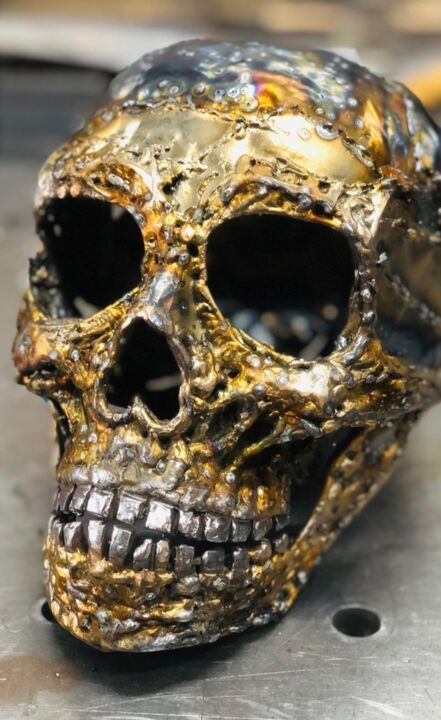 Kamil Zaitz, Gold mind, 2021. Stainless steel, Metals and Wire, 40 x 17 x 17 cm.
Kamil Zaitz, Gold mind, 2021. Stainless steel, Metals and Wire, 40 x 17 x 17 cm.
Kamil Zaitz: Gold mind
The skull, the subject of artwork made by Artmajeur's artist, Zaitz, has often been depicted in the most famous masterpieces of art history as a symbol of vanitas. The Latin expression vanitas vanitatum, derived from vanus and meaning transient, indicates in painting a type of still life characterized by the presence of objects, which are symbolic indicators of the precariousness of existence, the inexorability of the passage of time and the ephemeral nature of worldly goods. This iconography, of moralising intent, developed during the Middle Ages, when the Church had issued a severe warning, recalling how the wealth accumulated on earth, devoid of value, led to damnation. Consequently, in order to persuade sinners to redemption, the ecclesiastics had urged the pictorial representation of luxury goods, accompanied by objects that alluded to death. Zaitz's work represents, most likely, this figurative tradition in a very personal and innovative way, realizing the skull, which is the symbol of vanitas par excellence, in gold colored steel, a tonality indissolubly linked to the eternal and unreachable sacred celestial sphere. Consequently, the sculpture of the artist from Artmajeur seems to be a true oxymoron, in which eternal life and death are united.

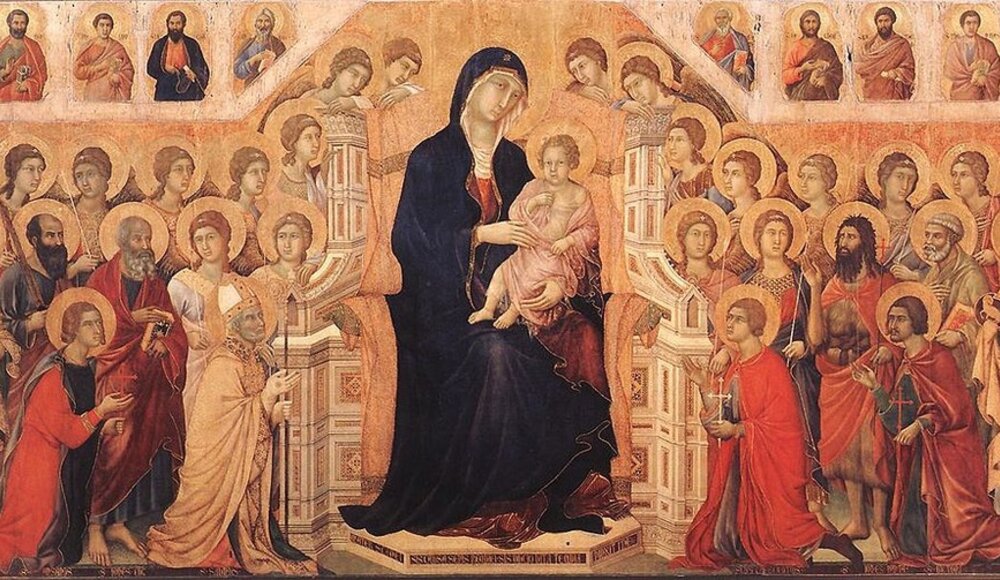
 Olimpia Gaia Martinelli
Olimpia Gaia Martinelli



